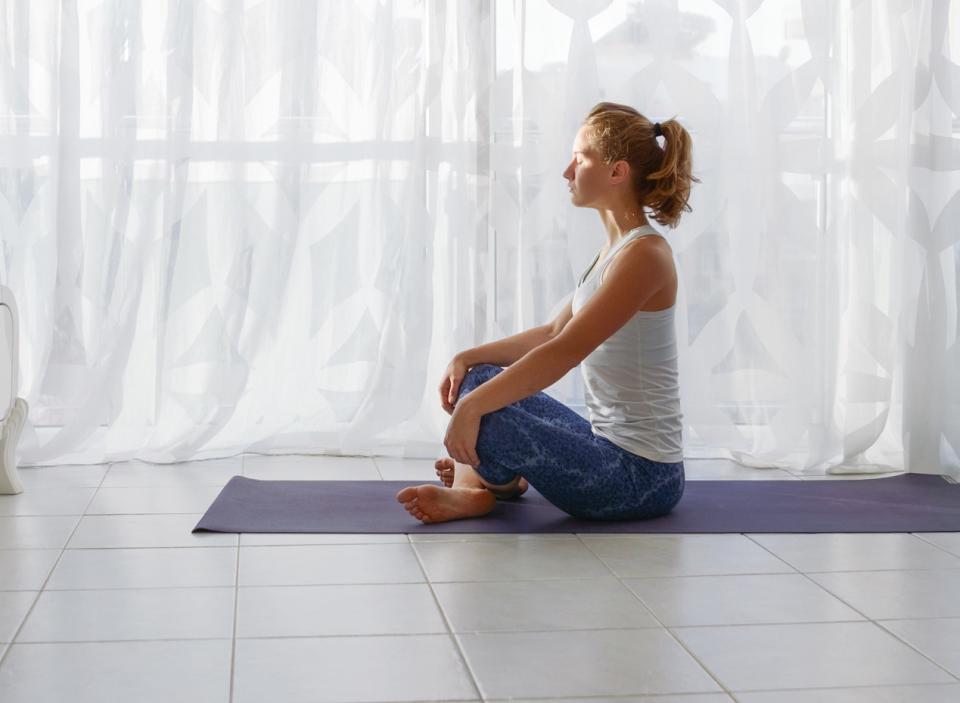5 Best Shoulder Stretches You Can Do at Your Desk
If you want to move your WFH setup to your couch (or bed, no judgment) there’s one thing you’ll need: a good set of shoulder stretches.
What with sitting at a computer all day, staring down at our phones, and working from a setup that probably doesn’t have the best back support, it’s not surprising that shoulder pain is a rising health concern among young women. Most concentrated tension is caused by misalignment, which causes muscles to firm up and create pain, stress, and stiffness. And even if you’re not feeling aches every minute of every day, shoulder pain can get worse over time, so it’s key to combat it early.
To keep you from getting totally bent out of shape, try these five expert-approved shoulder stretches that can be done literally anywhere—including in your living room or bedroom.
1. Deep Breathing

The first order of business: Practice your breathing, something you can do literally anywhere. “Deep breathing will help relax the shoulders, help make you aware of tension, and start to give you relief,” says holistic physical therapist Laura Probert. “If the only thing you did was change your breathing pattern, some part of your issue in the neck shoulders would improve.”
Breathing exercises are also a tried-and-true way to calm anxiety—something we could all use right now. “When you incorporate deep, diaphragmatic breathing into your day, you’ll drastically change the level of tension in your whole myofascial system as well as pull in much needed oxygen for tissue repair and healing,” Probert says.
Try it: Close your eyes and take a minimum of five deep, mindful inhales and exhales. Count to five on your inhale, and again on your exhale.
2. Forward Fold With Clasped Hands
Counteract the pain that slumped shoulders and a closed-off chest can cause with this easy forward bend from Sarah Larson Levey, the cofounder of Y7 Studio, a hip-hop yoga studio in New York City and Los Angeles.
Try it: Stand with feet hip-width apart. Upon exhale, soften knees and fold your torso forward, letting your head go to the ground. Straighten your arms behind your back and clasp your hands together. Stay there for five to ten deep breaths. “Be careful not to push your hands too far forward,” advises Larson Levey. “Also feel free to bend one knee and then the other, getting deeper into the shoulder.”
3. Wall Angels
To help open up the anterior side of the body, Equinox Tier X coach Matt Delaney suggests doing this shoulder-stretching exercise called wall angels (think snow angels with your back against the wall and your arms like a cactus). “This is a mobility drill that will help shoulders function optimally,” he says.
Try it: Lean your entire back against the wall with your feet slightly in front of you. With arms bent at a 90-degree angle, make contact with the wall with your elbows first, and then work to bring the tops of your hands against the wall at eye level, stopping wherever it feels comfortable. From there, begin to raise your arms above your head as you maintain all points of contact with the wall and slowly return back to the starting position. Do two to three sets of eight to ten reps. “As you become more comfortable with the movement, work to bring your forearms and tops of hands flush against the wall,” says Delaney.
4. Seated Shoulder Release
“For people who sit at a computer all day, the head, neck, chest, and shoulders are rounded and tight for way too long,” says Probert. This stretch, she says, opens up the front of the shoulders and neck to help counteract that forward flexion.
Try it: Sit in a chair and lean back. Place one of your hands on the center of your chest with your thumb and index finger touching your left and right collar bones, resting your palm flat. Place the other hand over the first one for support. Press your hands into your chest gently, then maintaining that pressure, start to pull your hands down hour torso until you feel tension in your shoulders. Stop there and hold for 30 to 45 seconds. You can gently tilt your head back and to each side to focus the stretch on one shoulder or side of the neck. “The connective tissue we’re addressing in this release will begin to change only after you’ve held the tissue for a long enough amount of time,” says Probert.
5. Standing Overhead Wall Stretch
When your arms stay by your sides all day, your range of motion is, unfortunately, very limited. Open it up with this simple shoulder exercise from Delaney; all you need is a wall.
Try it: Stand facing the wall with your feet about six inches away from it. Place the pinky side of your hands on the wall overhead, with your arms straight, and slowly let your chest fall through your arms toward the wall. Hold the end range, taking a couple of diaphragmatic breaths before returning to the starting position. “You should be conscious of engaging your core musculature by pulling your belly button into your spine as you let your chest sink in toward the wall,” says Delaney.
Originally Appeared on Glamour

